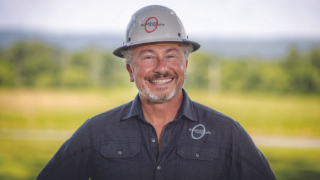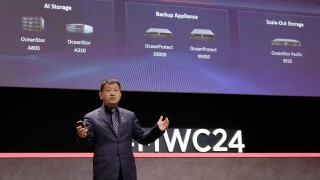|
Speed plays an important part in the world of John D’Ambrosia. A large proportion of his professional life is given over to the matter of speed – particularly the speed of Ethernet networks.
His other notable characteristic appears to be an inability to say “no” when asked to join yet another industry body. His full-time role is notionally chief Ethernet evangelist in the CTO office of server vendor Dell.
But he’s perhaps better known around the industry as founder and chairman of the Ethernet Alliance, a non-profit body dedicated to the expansion of Ethernet around the world.
In one role or another he’s been a leading light in the development of Ethernet-related technologies since 1999. This extends from his current chairing role in the IEEE P802.3bj 100Gb/s Backplane and Copper Cable Task Force to the IEEE 802.3 Higher Speed Ethernet Consensus Ad Hoc.
Past posts include being in charge of the Optical Internetworking Forum’s Market Awareness & Education committee, and heading the IEEE P802.3ba Task Force to develop the specifications for 40G and 100G Ethernet, as well. There goes his obsession with speed again.
Much of his best work for these various organisations has been about creating specifications for 100G Ethernet operation, setting out to amend the 802.3 Ethernet standard in order to stimulate the development of lower-cost, higher-density 100G Ethernet platforms.
D’Ambrosia believes not only that Ethernet should be fast, but cheap too, and available to all. At the present point of its evolution, 100G pricing can come in at upwards of $100,000 per port from some vendors, which effectively puts the technology out of reach for a lot of users.
Lightning speed
D’Ambrosia’s career has seen him move from Tyco to Force 10, then to Dell when it acquired Force 10, “moving up the food chain from components to networking” as he puts it. It was while at Force 10 he was first asked to work on standards, supporting a move from 10G to 100G.
“I was involved with working on migration to Ethernet at that time, so Force 10 said we might as well let John go and be a lightning rod for the industry,” he says. “I’ve been on a rocket ride ever since on that topic.”
D’Ambrosia believes the issue of higher Ethernet speeds is at an interesting point, but that consensus is a long way off between many competing factors and interests as to which track represents the optimal way to progress: “For example, do you go faster, or do you use modulation to send more information at a given speed, or do you add more fibres? If you opt to go faster, then you will start to run into challenges, and adding more fibres is not always a practical answer.”
Even though 10G is for many people still the cutting edge, he considers that now is the time to ask what comes after 100G: “Is it 1TB?” he muses. “Cost starts to become a bigger issue if you go there, and it’s not something you can just throw money at. If we go to 400Gb, how do we get there? At least everybody gets 400Gb, but that’s not the case with 1Tb. Looking into the future I’d say 1Tb is definitely going to be challenging.”
A future of interoperability
There is no kind of future for Fast Ethernet without agreement across the spectrum on a number of issues, and of course without interoperability between the R&D efforts of the vendor community. Interoperability is at the heart of a lot of D’Ambrosia’s work as he travels the globe chairing meetings, giving keynotes and just trying to get people in the same room having meaningful dialogue.
“There’s a difference between what the component people say versus what the end users are saying,” he believes. “It’s a debate with a lot of different stakeholders – carriers, Ethernet exchanges, the financial community. What you can say is that bandwidth needs are growing everywhere – it’s a global problem.”
D’Ambrosia’s work with the Ethernet Alliance centres around bringing people together in order to demonstrate how interoperability can work: “If we’re looking to the future, at forecasts, interop will play a part in that,” he explains. “We need to see multi-vendor interop, or that’s going to have an impact on cost per bit and generally on confidence. Cost pressure is on, lots of pressure is on and we need confidence in new technology and lots of focus on interoperability. It was 40Gb last year and 100Gb this year.”
He says he is often rewarded by glimmers of understanding, and by his occasional ability to get people to share his wonder in what is technically possible: “Last September I went to an interoperability demo, and it was great to see that people were blown away by the fact that this is real technology for real deployment,” he enthuses.
None of this progress, he believes, is possible without the dedication of people prepared to spend long hours serving on committees, fuelled by coffee and pizza as they thrash out differences.
“I often hear people say that standards bodies are too slow, too bureaucratic,” he says. “Maybe there’s sometimes a little truth in this, but not that much. You can’t always blame the forums when things go wrong. If the people in the industry can’t agree, whose fault is that? I’d argue it’s not the standards body. To achieve consensus involves talking with, not at, people – it’s about interpersonal relationships. But it’s not easy in an industry where the same three letter acronym can mean something completely different to one part of the industry to another.”
There is, he points out, no such thing as a unilateral standard: “If you ask an individual end user organisation to deal with interop problems, to replicate what the Ethernet Alliance does, it would be impossible. Our mission is to expand the ecosystem by demonstrating that all this stuff really does work.”
It is, he says, about the network in an end-to-end sense, and all the different technologies along the way, not just point A to point B: “An end-to-end perspective is a very big challenge, and it’s a battle to make headway with all these different aspects to consider,” he says. “As a result, I’m involved with so many different projects, which is either brave or stupid.”
An unashamed lover of technology, D’Ambrosia is also a firm believer in the human side of the equation: “Consensus is about people, all we can do [at the Ethernet Alliance] is provide a forum to bring them together for an intelligent conversation. When people come together they can make progress. Interoperability is our big mission and we use all the tools at our disposal, whether it’s face-to-face meetings or one that are on more of a virtual basis.”
The bigger picture
Most people’s perspective, he says with some exasperation, generally extends no further than their own tiny part of the problem, seldom seeing the bigger picture.
“To get past this is a matter of getting people together,” he claims. “I play my role by not losing sight of that big picture. That’s why I find it hard to say no when someone asks me to take on another role. But the fact of the matter is that having all these roles helps when you need a deep perspective. You need all these different ways of looking at things. You must never forget that bandwidth means nothing without interoperability. It’s easy to just focus on your little bit, but there’s always someone out there who sees it differently.”
Interoperability, he says, is practically never a matter of combining two things together: “No, no and no. Nothing is ever as simple as that. Even the best idea in the whole world isn’t going to be agreed by everybody at the same meeting. People will always want to go away and think about it, at the very least. I think that’s the human element and it will always play a big role in things. If I ask you what two plus two is, that’s easy, but if I ask you what’s the best networking architecture, that’s not so black and white.”
D’Ambrosia was set to follow his Capacity interview with three successive long-haul missions to China, India and then Switzerland, taking him away yet again from his home in California. How does he keep it up? Does he find it hard to take time out? Leisure time, it turns out, is one of the casualties of his frenetic lifestyle.
“Why do I do this?” he ponders. “Because it’s enjoyable. I love the technology. Apart from what I do, I have my family, two boys and a marriage of 20 years. How do I manage it all? Well, I drink a lot of energy drinks, and just sleep for a few hours a night. I guess I’ve got to learn to shut down better, but it’s hard when the implications are so huge. The implications range over so many areas – economic, technical of course, and social as well.”
Key Facts: Ethernet Alliance
History: The Ethernet Alliance is a global, non-profit, industry founded in 2006 by several member organisations, all dedicated to the continued success and advancement of Ethernet technologies.
Members include system and component vendors, industry experts, and university and government professionals. Ethernet Alliance members have collaborated over the years to take Ethernet standards to the marketplace. They claim to support and originate activities that span from incubation of new Ethernet technologies to interoperability testing to demonstrations to education.
The Ethernet Alliance was preceded by the Fast Ethernet Alliance, the Gigabit Ethernet Alliance (GEA), the 10 Gigabit Ethernet Alliance (10 GEA) and the Ethernet in the First Mile Alliance (EFMA).
Ownership: The Alliance is a member-driven organisation not owned by any one interest.
Head of the Alliance: John D’Ambrosia is one of the original founders and chairman.
Services: The Alliance provides no services for purchase, but does provide an unbiased, industry-based source of educational information to ensure interoperability among disparate, standards-based components and systems, to support the development of standards that support Ethernet technology and to bring together the Ethernet industry to collaborate on the future of the technology.








